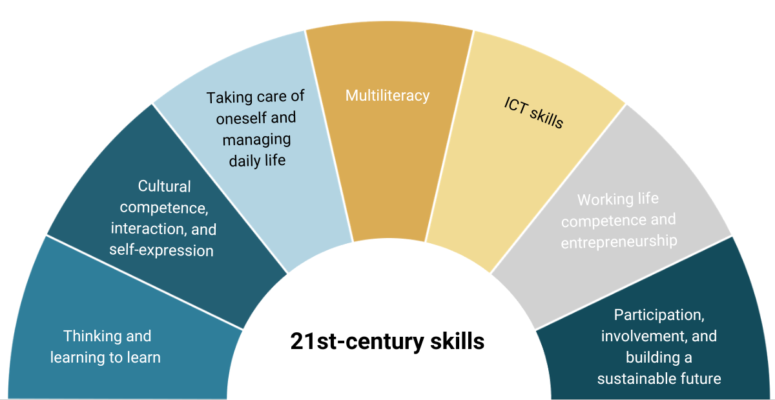A core principle of Finnish education model is to support students’ growth as individuals, enhance skills necessary for participating in tomorrow’s democratic society and make sustainable choices regardless of your age. This requires knowledge and competences that crosses boundaries and connects different fields of knowledge.
Finnish National Core Curriculum for Basic Education (2014) contains objectives, core content and evaluation criteria of all school subjects. It also introduces seven transversal competencies integrated into all subjects and school activities. These so-called 21st-century skills are tools that can be universally applied to enhance ways of thinking, learning, working and living in the world.
Our blog series will unlock the secrets of 21st century skills:

21st century skills – 5. Information and communication technology (ICT) skills
Advanced skills to use technology are essential, but also having a deeper understanding on how technology can support our lives becomes even more important in the future.
Along with constant development, technology enables learning to become more versatile, and more collaborative regardless of time or location. But even though our lives revolve around technologies and the internet, schools often don’t integrate them into the learning process efficiently due to several reasons: lack of access, lack of devices, lack of teacher training, lack of understanding or strict school policies. What ever the reasons are, the need for teacher training is real – how to use technology in teaching and how to introduce ICT skills to students? While students rely on modern tools and technologies daily with their smartphones, the learning process relies still more on traditional and often outdated teaching methods in teaching ICT.
Smartphones, tablets, and computers should no longer be seen as a distraction that disrupts the learning process but as necessary tools and skills which should be normal in a classroom. These devices are powerful tools for learning, communicating, searching, managing, and sharing information. ICT skills should be viewed as a vital part of multiliteracy. Although some schools are already battling with using too much technology in schools – then might be a good idea to focus on discussion, teamwork, and other activating methods instead.
Technologies enable learning to be more versatile and collaborative along with raising students’ proficiency in data management, data utilization, computer proficiency, and a range of IT programs, as well as secure internet activities. With education aiding digital skills and knowledge, students gain an opportunity to become active producers in the digital world while developing their digital know-how and participation instead of being just passive consumers. We already recognize that the younger generation is pioneering in many social media platforms such as TikTok and YouTube. ICT is a good topic to let the students share their expertise and learning with their peers – how does TikTok algorithm work or how to use Canva for creating visual presentations? Case examples and previous experiences are strong in learning such a complex topic.
Understanding technology and technological design
ICT skills are more than just the ability to use technology for learning – playing a math game, reading an e-book, or using Microsoft Office tools for school assignments. It’s understanding how technology is designed – this includes programming, algorithmic thinking, computational thinking abilities, artificial intelligence, virtual reality, and user experience. Modern technology is already affecting and controlling our daily choices more than we understand. Everyone does not need to be an engineer or data specialist or even understand what AR and VR are, but schools should have a more comprehensive approach to building students’ understanding of how to use technology safely and courteously inside and outside the school building. Parents should also teach their children skills regarding the usage of the internet or social media and how to communicate in different applications.
Despite technology-based learning requiring a lot of resources such as time, teacher training, and access to digital tools, it can start with smaller steps. Especially during the pandemic, when almost all schools switched to distance learning, teachers have more opportunities to implement ICT into daily learning from web-based whiteboards, interactive presentations, and online quizzes and games to entire online classrooms and courses. The internet is full of free materials, instructions, and examples. In the end, we want our students to rehearse ICT skills in school so they can have advanced skills in working life.
It is good to recognize that schools cannot be the only teachers of ICT skills. There is a need to involve parents, companies, and society to teach our children ICT skills regardless of geography, school, or gender.
This article is part of our series about 21st-century skills, a crucial theme in the future of education. See other parts of this series below:
- Part 1: Thinking and learning to learn
- Part 2: Cultural competence, interaction, and self-expression
- Part 3: Taking care of oneself and managing daily life
- Part 4: Multiliteracy
- Part 5: ICT skills
- Part 6: Working life competence and entrepreneurship
- Part 7: Participation, involvement, and building a sustainable future
